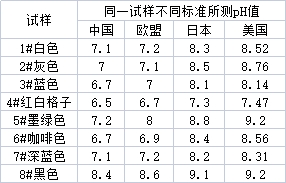The pH value is a very important quality indicator for textiles. It is a mandatory implementation indicator of GB18401-2010 “National Basic Safety Technical Specifications for Textiles”. Unqualified pH value is also the most common quality problem in the process of textile processing, production and trade. It has attracted more and more attention. This article will discuss with you how to control the pH value of textiles.
1. Definition of pH value:
The pH value is acidity and alkalinity, and human skin is slightly acidic. , can prevent the invasion of germs under such environmental conditions, so if the pH value of textiles is between slightly acidic or neutral, it will help protect human health; on the contrary, if the pH value of textiles is too high or too low, it will destroy the balance and balance of the skin. resistance, thereby causing skin allergies or inducing infection and causing bacterial invasion.
2. Requirements for pH limit value:
3. Source of abnormal pH:
Mainly due to textile dyeing Insufficient pH control during the whole process, insufficient acid neutralization after wet treatment, or incomplete cleaning, the dyeing and finishing processes that can easily cause pH abnormalities are mainly alkali reduction, polyester printing washing, reactive printing washing, cotton desizing, and scouring. and mercerizing etc.
4. Comparison of different methods for measuring the pH value of textiles:
(1), Chinese Standard (GB/T7573-2009)
Weigh 3 samples of 2±0.05g, cut them into small pieces of 5×5mm, and put them in In a flask containing 100 ml of distilled water, shake the flask to fully soak the sample. Place the flask on the oscillator and shake for 2 hours ± 5 minutes. Then directly measure the pH value of the water extract (excluding fabric) with a pH meter at room temperature. Each sample is tested three times, and the average of the results of the second and third samples is taken as the final result, accurate to 0.1.
(2), EU standard (EN1413-1998)
Weigh 3 portions of 2± 0.05g sample, cut it into small pieces of 5×5mm, put it into a flask containing 100ml potassium chloride solution (0.1mol/L) or 100ml distilled water, shake the flask to fully soak the sample, and place the flask on After shaking on the oscillator for 2 hours, directly measure the pH value of the water extract (excluding fabric) with a pH meter at room temperature. Do three tests for each sample, and take the average of the results of the second and third samples as The final result is accurate to 0.1.
(3), Japanese standard (JISL1096-1999)
Weigh 5±0.1g Cut the sample into 1×1mm small pieces, boil it in 50ml distilled water for 2 minutes, put the sample in the flask, shake the flask to fully soak the sample, let it stand at room temperature for 30 minutes, remove the sample Sample, when the temperature of the water extract reaches 25±2°C, use a pH meter to directly measure the pH value of the water extract, accurate to 0.1.
(4), American standard (AATCC81-2001)
Weigh 10±0.1g Cut the sample into small pieces, boil it in 250ml distilled water for 10 minutes, put the sample in the flask, shake the flask to fully soak the sample, continue boiling for 10 minutes, cool to room temperature, remove the sample Take a sample and directly measure the pH value of the water extract with a pH meter, accurate to 0.01.
PH value of cotton fabric water extract under different measurement standards:

5. What to do if the pH of textiles is found to be unqualified?
If the pH of the fabric or garment is found to be unqualified, the pH of the fabric is generally re-adjusted through the principle of acid-base neutralization. Most of the unqualified pH is alkaline. There are many kinds of acids that can be used to adjust. The most common ones are glacial acetic acid and citric acid. Glacial acetic acid is volatile and has a pungent smell. Citric acid adjusts the pH more stably, so It is generally recommended to use citric acid for adjustment, but attention should be paid to controlling the dosage. Excessive use will affect the feel and easily cause yellowing.
For example: If the measured pH value of the fabric is 9-10, you can adjust the pH value of the citric acid aqueous solution to 4-5, then soak it for 10 minutes and dry it. Before sending to customers, formal inspection and structural testing will be carried out to confirm that they are qualified to reduce trade risks.
6. How to control pH value:
Only by analyzing pH Only by identifying the reasons for unqualified pH values and taking appropriate measures can we effectively reduce the unqualified rate of textile pH values:
(1) Fabric companies should strengthen the quality awareness of relevant quality control personnel and textile standards Study and training work to correctly understand the pH requirements of textiles. Garment processing companies must also select appropriate fabrics and accessories based on the garment’s own requirements and safety categories, and provide accurate requirements and standards to fabric suppliers. Only by paying attention to the source and conducting quality control can we avoid trade disputes caused by unqualified pH.
(2) Relevant personnel of dyeing and finishing enterprises should take the initiative to learn ecological textile safety knowledge, be familiar with standard requirements, take the initiative to pay attention to the inherent quality of printing and dyeing products, optimize production processes, and take the initiative to improve technical levels.
(3), Inspection agencies or corporate laboratories should strictly follow the inspection standards.��Carry out testing to ensure that the inspection data is fair and accurate, avoid testing data errors caused by improper operation and other human factors, and truly control product quality. </p







